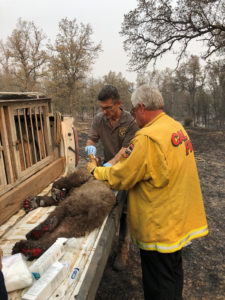Brown pelicans migrating from Washington and Oregon back to California have been experiencing severe flight delays due to winter weather. Adult birds have been making crash landings in unusual places and showing signs of disorientation and starvation. Some have even been found dead.
Initially puzzled by the birds’ ailment, scientists now concur that the main cause of harm was frostbite suffered when winter storms hit the Northwest in December 2008.
The mystery of the birds’ sudden illness is tied to their migratory patterns. California brown pelicans live year-round from Baja to Point Conception, near Santa Barbara. They disperse northward and forage for food in warmer months, and recently these travels have led them farther and farther north–all the way to British Columbia in some instances.
This December, counts of the birds in Oregon tallied “unprecedented amounts,” says University of Southern California research professor Dave Caron. Then a cold snap with wet and icy storms struck the region.
Initial concerns that domoic acid–a toxin produced by algae in the Pacific Ocean–could be poisoning the birds have been put to rest. Caron’s lab at USC found the toxin in only a handful of algae samples, and those even those levels were low. “Only a few types of algae produce domoic acid,” says Caron, “and we see those kinds of toxins at low levels throughout the year.” The tests run at the Caron lab found toxins “at a concentration 100-fold less than a toxic event.”
Pelicans exposed to wet and freezing conditions, however, are more vulnerable to even low amounts of domoic acid. A small portion of birds have tested positive for domoic acid in recent blood tests. Toxin levels do not reach those commonly found during past toxic events. But, with weather-ravaged birds, “any small amount of domoic acid can put [pelicans] over the edge,” says Caron.
“The consensus of the experts at this time is still that, while domoic acid might be playing a part, it is a secondary problem,” says Laurie Pyne of the Cordelia-based International Bird Rescue and Research Center.
Several Bay Area organizations have been coordinating bird rescue and rehabilitation. Pyne reports that more than sixty birds have been brought into IBRRC’s Bay Area headquarters in Fairfield. Humane societies have collected ailing birds and transported them to appropriate rehabilitation centers. Nakeisha Brown of San Francisco Animal Care and Control reports that at least three birds have been reported to the agency. “I transported two birds to the Peninsula Humane Society–two stinky birds,” Brown says. The pelicans, alive but lethargic, were found in a dumpster by garbage collectors at Pier 45. It is unknown how the birds ended up in the dumpster or how long they had been there, unable to fly out of their own accord.
Unfortunately, rehabilitating the pelicans is a costly affair requiring medications and loads of smelt and squid for the starved birds.
If you’d like to help rehabilitate a local pelican, the International Bird Rescue and Research Center has adopt-a-pelican programs suitable for individual donors or classrooms whose students would like to witness their pelican being released into the wild. Call them at (707) 207-0380 or visit their website for more information.

.jpg)



